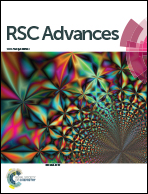Spatially branched CdS–Bi2S3 heteroarchitecture: single step hydrothermal synthesis approach with enhanced field emission performance and highly responsive broadband photodetection†
Abstract
This report explores the controlled hierarchical synthesis of CdS nanostructure branches on Bi2S3 nanorod cores via a facile single step hydrothermal route. Morphological and structural studies reveal the formation of CdS–Bi2S3 heteroarchitecture with excellent stoichiometry between the constituent elements. The growth of CdS over Bi2S3 strongly depends on optimization of the reaction conditions, especially low PVP concentration. Furthermore, the as-synthesized CdS–Bi2S3 heteroarchitecture demonstrates multifunctionality in field emission and photoresponse. Interestingly, the CdS–Bi2S3 heteroarchitecture shows enhanced field emission properties such as low turn-on field (∼1.8 V μm−1 for 10 μA cm2), high emission current density and better current stability in comparison to Bi2S3 and other nanostructures. The as-synthesized CdS–Bi2S3 heteroarchitecture exhibits considerable response and recovery times, ∼207 ms and 315 ms, respectively in comparison to bare Bi2S3 nanostructures (∼655 ms and 678 ms). The present results demonstrate CdS–Bi2S3 heteroarchitecture as a potential candidate for future optoelectronic device applications.


 Please wait while we load your content...
Please wait while we load your content...